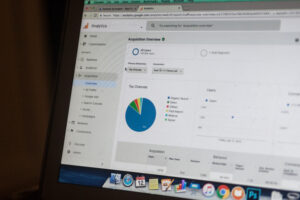
How to measure your PR efforts to see if it is working
A column by Kathryn Byberg, Managing Director Little Leaf Agency (littleleaf.agency
In the ever-growing, ever-changing world of public relations, the full impact of PR activities can be difficult to track. However, it’s essential to track results to see if PR delivered a return on the investment. How do you measure the success of a PR initiative? It’s not just about media coverage and if that is all you are tracking, then there’s a chance you are missing out on some key impacts of PR. It’s also not just about generating sales, though that is a nice perk. There are so many different methods of measuring performance, depending on what you want to track, but ultimately the overarching goal is to make sure your brand is being seen positively by the public. Back in the day coverage was measured based on how many press clippings you received, and how much that placement would cost, along with readership and any other relevant metrics that you could gather without the use of the software. Many old-school PR agencies will try and sell you on the success of their efforts based on these metrics, but in a world where e-commerce is becoming more important to business strategy, there are many other metrics you can, and should, be monitoring and many of them are free too!
Setting out KPIs
We do still look at press clippings, and we still measure the success of print, but there is so much more we can look at now too.
Firstly, it’s important to map out your goals. To measure any PR campaign, you establish your Key Performance Indicators (KPIs).
Traffic to your website, or maybe brand awareness? Getting featured in listicles? Backlinks to your brand’s website? Increasing organic or referral traffic?
Once you have determined your goals, your PR team can write pitches and press releases, and target select reporters with these KPIs in mind.
Types of PR content
If you want brand awareness, then brand campaigns, CEO opinion pieces, and interesting news stories, that spread around, are a great way to do this. But these types of coverage peak early and then rarely generate traffic months down the line. They are top of the funnel, so they will get your brand in front of people, but not necessarily the people who will purchase.
Listicles on the other hand are what we call “evergreen content”. They will not bring massive amounts of traffic in a short period of time, but they will bring small amounts over a long period, even years. These types of articles are typically SEO heavy and will show up high in google searches when people are specifically searching for this type of content. These people are further down the marketing funnel and are more likely to convert to a sale.
If you are launching a new product, then reviews are another key type of content that you will want. Consumers can’t try out a sex toy before purchasing it, so they rely on reviews to make informed decisions. These review articles may not bring any traffic to your site, but they are an important part of the consumer journey. If someone has already read about your product in a listicle, then a savvy consumer might do more research and look for product reviews.
There are many different types of content and depending on which type you are trying to secure, the results you measure will be different.

Tiers of Coverage
Just like there are different types of content there are different tiers of media. Big mainstream names like Cosmopolitan, Vice, Vogue, GQ and Mashable are all Tier 1 media. They have a lot of readers and the potential to put your brand in front of a lot of people. Plus they are well respected and a nod to your brand in one of these from a respected editor gives credibility to your products..
SEO and DA
Another really important metric to measure, is domain authority, not just in PR but for marketing too. The higher your domain authority, the higher your site will sit on search results. The more links you get from big tier-one sites back to your site, the higher your DA will become.
One of two well-placed backlinks to your site on a tier-1 site can do wonders for your brand’s SEO and will have a bigger impact than multiple pieces of coverage on smaller sites.
How can you tell how big a publisher is?
Domain Authority can be tracked using free tools like Moz Blog. A link from a publisher with a DA of over 80 back to your site can be more valuable than 10 links from a website with a DA of 20.
Unique Monthly Visitors
When looking at DA, and links back through to your website, it’s important to note unique monthly visitors.
UMV is the number of people that have visited a website for the first time over a month, this is different from overall website hits, as this includes people that have come back. While not every single one of these visitors to a site will have read our brand’s article, it is something we can measure to get an idea of the potential reach of that article.
You can measure this with free tools like Similarweb. While not 100% accurate it gives a rough idea.
Google Analytics
You can also tell if your PR campaign has been successful, as there may be a spike in traffic, particularly from brand campaigns and news alerts, when looking at Google Analytics or the back end of your website.
Here you can work in unison with your marketing team to review data in direct, organic searches and referral traffic. While referrals are good to measure, as you can track people clicking on backlinks in articles, it’s not entirely accurate. Many people do not like to click links. They might Google your brand after reading about it, so the organic search will go up. If the url to your site was printed then they might type it in directly to their search bar.

Share of Voice
Another metric to look at to determine the success of your PR is how many mentions your brand gets compared to competitors. You can look at social chatter, trends in topics and any other mentions of your brand! You can find social listening tools on platforms such as Cision, MuckRack and MeltWater, though these can come with a hefty price tag.
Key Messaging
Of course, all of these metrics to measure success are important, but it’s important to remember the purpose of the campaign in the first place. Was the message clear, and have you hit the goals you mapped out? Did the message you were trying to convey become apparent throughout the coverage? A great starting point, within your team, is to have a key messaging document to refer back to, and once the coverage lands, check against this document to see if the key messaging is portrayed. Did you land in outlets that you wanted to feature in? Did you gain the coverage you wanted?
Sales and Conversions
Ultimately, PR is not about driving sales, it’s about building a reputation and gaining awareness. PR will help you gain testimonials, reviews, and traffic. It’s about building the brand. PR is a good way to get qualified traffic to your site, however, if your website has a confusing consumer journey and low conversion rate, then the sales will not come, no matter how much traffic you generate.
When entering the world of PR, it’s important to remember that the purpose of PR isn’t to drive sales, but it’s even more important to remember that the sales, marketing, and web team need to work in unison to make sure all channels are running effectively.




